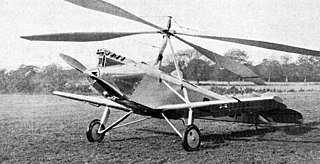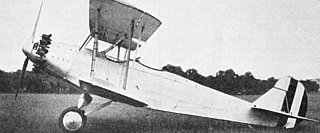
The Auster J/4 was a 1940s British single-engined two-seat high-wing touring monoplane built by Auster Aircraft Limited at Rearsby, Leicestershire.

The Albatros L 75 Ass was a German trainer biplane of the 1920s. Of conventional configuration, it seated the pilot and instructor in separate, open cockpits. The wings were single-bay, equal-span, and had a slight stagger. Production continued after Albatros was absorbed by Focke-Wulf.
The Auster Avis was a four-seat light aircraft developed from the Auster Autocrat. It featured a redesigned fuselage incorporating four doors and a circular cross-section towards the tail, new undercarriage, and new wing flaps. It was planned in two versions, the Mk 1 for civil use, and the Mk 2 for military and air ambulance duties. However, only two prototypes were built, and Auster abandoned the project in favour of the Auster J-5 Autocar.

The Breda A.4 was a biplane trainer produced in Italy in the mid-1920s. It was of conventional configuration with a two-bay unstaggered wing cellule and seating for the pilot and instructor in tandem open cockpits. Apart from civil use, the A.4 was also adopted by the Regia Aeronautica as a trainer. At least some examples were produced in floatplane configuration as the A.4idro.

The Cierva C.17 was a British experimental autogyro built by Cierva Autogiro Company in England in 1928, in association with Avro. It was an attempt to build upon the successful Cierva C.8 design using the smaller, more streamlined fuselage of an Avro Avian IIIA as a starting point. The type was found to be underpowered, and when the first attempt at fitting a more powerful engine still did not result in acceptable performance, the design was abandoned.
The Piper PA-6 Sky Sedan was a 1940s American four-seat light aircraft designed and built in prototype form by Piper Aircraft at its Lock Haven, Pennsylvania, factory.

The Heinkel HD 22 was a trainer designed in Germany during the 1920s. It was a conventional single-bay biplane with staggered wings braced with N-type interplane struts. The pilot and instructor sat in tandem, open cockpits, and the main units of the fixed, tailskid undercarriage were linked by a cross-axle.

The Keystone K-55 Pronto was a mail plane developed in the United States in the late 1920s. It was a conventional single-bay, unequal-span biplane design with slightly staggered wings. The pilot sat in an open cockpit, in tandem with a second cockpit that could carry two passengers side-by-side. The fixed, tailskid undercarriage had divided main units.
The Spartan C4 is an American four-seat cabin monoplane designed and built by the Spartan Aircraft Company.
The Aeronca 12AC Chum was a 2-seat cabin monoplane designed and produced by Aeronca in the United States in 1946. The design was a licence-built version of the ERCO Ercoupe.
The Skandinaviska Aero BHT-1 Beauty is a 1940s Swedish single-seat light monoplane designed by E. Bratt, K.E. Hilfing and B.Törnblom and built by Skandinaviska Aero of Stockholm.

The Elias EC-1 Aircoupe was an American two-seat parasol wing monoplane designed and built by Elias of Buffalo, New York.
The Preceptor Stinger is an American homebuilt aircraft that was designed and produced by Preceptor Aircraft of Rutherfordton, North Carolina. When it was available the aircraft was supplied as plans or as a kit for amateur construction.
The Take Off Merlin is a German ultralight trike, designed and produced by Take Off GmbH of Hamm. The aircraft is supplied as a complete ready-to-fly-aircraft.
The Schmidtler Enduro is a German ultralight trike that was designed and produced by Ultraleichtflug Schmidtler of Munich. When it was available the aircraft was supplied as a complete ready-to-fly-aircraft.
The Eaves Cougar 1 is an American homebuilt aircraft that was designed by Leonard R. Eaves of Oklahoma City, Oklahoma and made available in the form of plans for amateur construction.
The Deland Travel Air 2000 is an American homebuilt aircraft that was designed and produced by Orlando Helicopter Airways, an aircraft maintenance and repair company located in DeLand, Florida. When it was available the aircraft was supplied as a kit for amateur construction and marketed under the "Deland" brand, named for the company's location. Plans were also available.
The Vancil Spitz S1 is an American homebuilt aircraft that was designed and produced by A. Vancil of Belton, South Carolina, introduced in the late 1990s. When it was available the aircraft was supplied as a kit and also in the form of plans for amateur construction.
The Adventure Wheely II is a French powered parachute that was designed and produced by Adventure SA of Paris. Now out of production, when it was available the aircraft was supplied as a complete ready-to-fly-aircraft.
The Roland Z-120 Relax is a German ultralight aircraft, designed and produced by Roland Aircraft of Mendig, introduced at the AERO Friedrichshafen show in 2015. The aircraft is supplied as a kit for amateur construction or complete and ready-to-fly.










